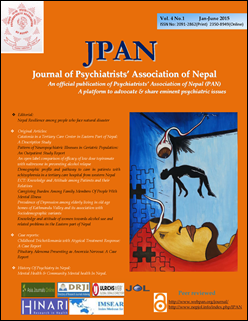Catatonia in a Tertiary Care Center in Eastern Part of Nepal: A Descriptive Study
DOI:
https://doi.org/10.3126/jpan.v4i1.16736Keywords:
Catatonia, Phenomenology, NepalAbstract
Introduction: Catatonia is still an ill-understood phenomenology and we could not find any case based publications from Nepal. This study was undertaken to observe the proportion of catatonic patients in a year, to describe their frequencies, and to relate catatonia to mode of onset of catatonia, stressors and to diagnostic categories.
Method: One-year prospective study was carried out in Psychiatry Ward of B. P. Koirala Institute of Health Sciences, Dharan. Socio-demographic variables were collected in structured Performa and Semi-Structured Performa was used for number of catatonic signs, life events, and mode of onset. Catatonia was screened and rated by Bush-Francis Catatonia Rating Scale. Psychiatric diagnoses were based on International Classification of Mental and Behavioral Disorder, Diagnostic and Research Guidelines, tenth version. Medical diagnoses were made by the consultant in Internal Medicine. Those who could not be admitted at least 24 hours for observation were not taken into study and 2 cases were excluded due to extreme of ages.
Result: The proportions of patients with catatonia were 9.3% in psychiatric in-patients. Mutism was the most common sign and larger proportion had retarded catatonia. Mode of onset of catatonia, stressors, and disorders were not related. Medical and psychiatric catatonia could not be differentiated from the pattern of catatonic signs, even though echolalia occurred only in seizure disorder in our sample.
Conclusion: The phenomenon of catatonia is common in our set-up. Mutism was the most common symptom. It is important to rule out organic etiology first. Depression is a common diagnosis with catatonia.
Downloads
Downloads
Published
How to Cite
Issue
Section
License
This license enables reusers to distribute, remix, adapt, and build upon the material in any medium or format, so long as attribution is given to the creator. The license allows for commercial use.




